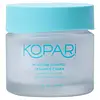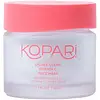What's inside
What's inside
 Key Ingredients
Key Ingredients

 Benefits
Benefits

 Concerns
Concerns

 Ingredients Side-by-side
Ingredients Side-by-side

Water
Skin ConditioningGlycerin
HumectantCaprylic/Capric Triglyceride
MaskingOctyldodecanol
EmollientDicaprylyl Ether
Emollient2,3-Butanediol
HumectantGlyceryl Stearate Citrate
EmollientCetearyl Alcohol
Emollient1,2-Hexanediol
Skin ConditioningSqualane
EmollientButyrospermum Parkii Butter
Skin ConditioningBehenyl Alcohol
EmollientHydrogenated Lecithin
EmulsifyingPolyglyceryl-10 Stearate
Skin ConditioningSodium Polyacrylate
AbsorbentBehenic Acid
CleansingStearic Acid
CleansingStearyl Alcohol
EmollientCocos Nucifera Fruit Extract
EmollientMyristic Acid
CleansingSimmondsia Chinensis Seed Oil
EmollientCeramide NP
Skin ConditioningTriethylhexanoin
MaskingPhospholipids
Skin ConditioningEthylhexylglycerin
Skin ConditioningHydrogenated Polydecene
EmollientAdansonia Digitata Seed Oil
EmollientCitrullus Lanatus Seed Oil
EmollientGlyceryl Undecylenate
EmollientGlyceryl Caprylate
EmollientCholesterol
EmollientPropanediol
SolventPhytosphingosine
Skin ConditioningTocopherol
AntioxidantAloe Barbadensis Leaf Juice
Skin ConditioningAdansonia Digitata Fruit Extract
EmollientXanthan Gum
EmulsifyingSodium Hyaluronate
HumectantWater, Glycerin, Caprylic/Capric Triglyceride, Octyldodecanol, Dicaprylyl Ether, 2,3-Butanediol, Glyceryl Stearate Citrate, Cetearyl Alcohol, 1,2-Hexanediol, Squalane, Butyrospermum Parkii Butter, Behenyl Alcohol, Hydrogenated Lecithin, Polyglyceryl-10 Stearate, Sodium Polyacrylate, Behenic Acid, Stearic Acid, Stearyl Alcohol, Cocos Nucifera Fruit Extract, Myristic Acid, Simmondsia Chinensis Seed Oil, Ceramide NP, Triethylhexanoin, Phospholipids, Ethylhexylglycerin, Hydrogenated Polydecene, Adansonia Digitata Seed Oil, Citrullus Lanatus Seed Oil, Glyceryl Undecylenate, Glyceryl Caprylate, Cholesterol, Propanediol, Phytosphingosine, Tocopherol, Aloe Barbadensis Leaf Juice, Adansonia Digitata Fruit Extract, Xanthan Gum, Sodium Hyaluronate
Water
Skin ConditioningGlycerin
HumectantCaprylic/Capric Triglyceride
MaskingMethyl Glucose Sesquistearate
EmollientCoco-Caprylate/Caprate
EmollientIsostearyl Linoleate
EmollientZinc Oxide
Cosmetic ColorantButyrospermum Parkii Butter
Skin ConditioningStearyl Alcohol
EmollientSilica
AbrasiveCetyl Alcohol
EmollientGlyceryl Stearate Citrate
EmollientLitchi Chinensis Seed Extract
Skin ConditioningAscorbyl Glucoside
AntioxidantVaccinium Myrtillus Fruit Extract
Skin ConditioningSaccharum Officinarum Extract
MoisturisingAcer Saccharum Extract
Skin ConditioningPyrus Malus Fruit Extract
Skin ConditioningSalix Alba Bark Extract
AstringentCocos Nucifera Fruit Extract
EmollientLavandula Angustifolia Flower/Leaf/Stem Extract
MaskingOcimum Sanctum Leaf Extract
Skin ConditioningAnanas Sativus Fruit Extract
Skin ConditioningRubus Idaeus Fruit Extract
AstringentPrunus Armeniaca Fruit Extract
Skin ConditioningVanilla Planifolia Fruit Extract
Skin ConditioningPassiflora Incarnata Fruit Extract
Skin ConditioningPrunus Persica Fruit Extract
AbrasiveMusa Sapientum Fruit Extract
Skin ConditioningSolanum Melongena Fruit Extract
Skin ConditioningMelia Azadirachta Flower Extract
Skin ConditioningMelia Azadirachta Leaf Extract
Skin ConditioningCoccinia Indica Fruit Extract
Skin ConditioningCitrus Limon Fruit Extract
MaskingCitrus Paradisi Fruit Extract
Skin ConditioningAloe Barbadensis Flower Extract
EmollientCitrus Aurantium Dulcis Fruit Extract
MaskingCitrus Aurantium Dulcis Peel Extract
Emulsion StabilisingCitrus Aurantifolia Peel Extract
CleansingCitrus Limon Peel Extract
EmollientZea Mays Starch
AbsorbentXanthan Gum
EmulsifyingCetearyl Alcohol
Emollient1,2-Hexanediol
Skin ConditioningCaprylyl Glycol
EmollientGlyceryl Caprylate
EmollientSclerotium Gum
Emulsion StabilisingPullulan
Triethyl Citrate
MaskingSodium Stearoyl Glutamate
CleansingPolyacrylate Crosspolymer-6
Emulsion StabilisingLecithin
EmollientPotassium Sorbate
PreservativeCitric Acid
BufferingSodium Benzoate
MaskingDisodium EDTA
Phenoxyethanol
PreservativeWater, Glycerin, Caprylic/Capric Triglyceride, Methyl Glucose Sesquistearate, Coco-Caprylate/Caprate, Isostearyl Linoleate, Zinc Oxide, Butyrospermum Parkii Butter, Stearyl Alcohol, Silica, Cetyl Alcohol, Glyceryl Stearate Citrate, Litchi Chinensis Seed Extract, Ascorbyl Glucoside, Vaccinium Myrtillus Fruit Extract, Saccharum Officinarum Extract, Acer Saccharum Extract, Pyrus Malus Fruit Extract, Salix Alba Bark Extract, Cocos Nucifera Fruit Extract, Lavandula Angustifolia Flower/Leaf/Stem Extract, Ocimum Sanctum Leaf Extract, Ananas Sativus Fruit Extract, Rubus Idaeus Fruit Extract, Prunus Armeniaca Fruit Extract, Vanilla Planifolia Fruit Extract, Passiflora Incarnata Fruit Extract, Prunus Persica Fruit Extract, Musa Sapientum Fruit Extract, Solanum Melongena Fruit Extract, Melia Azadirachta Flower Extract, Melia Azadirachta Leaf Extract, Coccinia Indica Fruit Extract, Citrus Limon Fruit Extract, Citrus Paradisi Fruit Extract, Aloe Barbadensis Flower Extract, Citrus Aurantium Dulcis Fruit Extract, Citrus Aurantium Dulcis Peel Extract, Citrus Aurantifolia Peel Extract, Citrus Limon Peel Extract, Zea Mays Starch, Xanthan Gum, Cetearyl Alcohol, 1,2-Hexanediol, Caprylyl Glycol, Glyceryl Caprylate, Sclerotium Gum, Pullulan, Triethyl Citrate, Sodium Stearoyl Glutamate, Polyacrylate Crosspolymer-6, Lecithin, Potassium Sorbate, Citric Acid, Sodium Benzoate, Disodium EDTA, Phenoxyethanol
Ingredients Explained
These ingredients are found in both products.
Ingredients higher up in an ingredient list are typically present in a larger amount.
1,2-Hexanediol is a synthetic liquid and another multi-functional powerhouse.
It is a:
- Humectant, drawing moisture into the skin
- Emollient, helping to soften skin
- Solvent, dispersing and stabilizing formulas
- Preservative booster, enhancing the antimicrobial activity of other preservatives
This ingredient is also known as shea butter. It is an effective skin hydrator and emollient.
Emollients help soothe and soften your skin. It does this by creating a protective film on your skin. This barrier helps trap moisture and keeps your skin hydrated. Emollients may be effective at treating dry or itchy skin.
Shea butter is rich in antioxidants. Antioxidants help fight free-radicals, or molecules that may harm the body. It is also full of fatty acids including stearic acid and linoleic acid. These acids help replenish the skin and keep skin moisturized.
While Shea Butter has an SPF rating of about 3-4, it is not a sunscreen replacement.
Shea butter may not be fungal acne safe. We recommend speaking with a professional if you have any concerns.
Learn more about Butyrospermum Parkii ButterThis ingredient is an emollient, solvent, and texture enhancer. It is considered a skin-softener by helping the skin prevent moisture loss.
It helps thicken a product's formula and makes it easier to spread by dissolving clumping compounds.
Caprylic Triglyceride is made by combining glycerin with coconut oil, forming a clear liquid.
While there is an assumption Caprylic Triglyceride can clog pores due to it being derived from coconut oil, there is no research supporting this.
Learn more about Caprylic/Capric TriglycerideCetearyl alcohol is a mixture of two fatty alcohols: cetyl alcohol and stearyl alcohol. It is mainly used as an emulsifier. Emulsifiers help prevent the separation of oils and products. Due to its composition, it can also be used to thicken a product or help create foam.
Cetearyl alcohol is an emollient. Emollients help soothe and hydrate the skin by trapping moisture.
Studies show Cetearyl alcohol is non-toxic and non-irritating. The FDA allows products labeled "alcohol-free" to have fatty alcohols.
This ingredient is usually derived from plant oils such as palm, vegetable, or coconut oils. There is debate on whether this ingredient will cause acne.
Due to the fatty acid base, this ingredient may not be Malassezia folliculitis safe.
Learn more about Cetearyl AlcoholCocos Nucifera Fruit Extract comes from the meat of the coconut fruit. It is an emollient and skin conditioner with antioxidant properties.
Coconut fruit is naturally rich in amino acids, sugars, and nutrients including Vitamin C and small amounts of vitamin B. Malic acid can also be found in coconut fruit extract.
Glycerin is already naturally found in your skin. It helps moisturize and protect your skin.
A study from 2016 found glycerin to be more effective as a humectant than AHAs and hyaluronic acid.
As a humectant, it helps the skin stay hydrated by pulling moisture to your skin. The low molecular weight of glycerin allows it to pull moisture into the deeper layers of your skin.
Hydrated skin improves your skin barrier; Your skin barrier helps protect against irritants and bacteria.
Glycerin has also been found to have antimicrobial and antiviral properties. Due to these properties, glycerin is often used in wound and burn treatments.
In cosmetics, glycerin is usually derived from plants such as soybean or palm. However, it can also be sourced from animals, such as tallow or animal fat.
This ingredient is organic, colorless, odorless, and non-toxic.
Glycerin is the name for this ingredient in American English. British English uses Glycerol/Glycerine.
Learn more about GlycerinGlyceryl Caprylate comes from glycerin and caprylic acid, a fatty acid from coconut. It has emollient and emulsifier properties.
As an emollient, it helps hydrate your skin. Emollients work by creating a barrier on your skin to trap moisture in, helping to keep your skin soft and smooth.
On the other hand, emulsifiers prevent ingredients (such as oil and water) from separating.
Learn more about Glyceryl CaprylateGlyceryl Stearate Citrate is a citric acid ester of glyceryl stearate.
It is an emulsifier, emollient, and a surfactant.
Emulsifiers help stabilize a product. It does this by preventing certain ingredients from separating. Common ingredients include oils and water, which do not mix naturally. Emulsifiers have properties that help keep ingredients such as these together.
Emollients help soothe and soften the skin. They do this by creating a protective film on your skin. This barrier helps trap moisture and keeps your skin hydrated. Emollients may be effective at treating dry or itchy skin.
Surfactants help gather oils, dirt, and other pollutants from the skin. This helps them to be easily rinsed away.
Learn more about Glyceryl Stearate CitrateStearyl Alcohol is a type of fatty alcohol from stearic acid. It is a white, waxy compound used to emulsify ingredients.
Fatty Alcohols are most often used as an emollient or to thicken a product. Emollients help soothe and hydrate the skin by trapping moisture.
They are usually derived from natural fats and oils and therefore do not have the same drying or irritating effect as solvent alcohols. FDA allows products labeled "alcohol-free" to have fatty alcohols.
Learn more about Stearyl AlcoholWater. It's the most common cosmetic ingredient of all. You'll usually see it at the top of ingredient lists, meaning that it makes up the largest part of the product.
So why is it so popular? Water most often acts as a solvent - this means that it helps dissolve other ingredients into the formulation.
You'll also recognize water as that liquid we all need to stay alive. If you see this, drink a glass of water. Stay hydrated!
Learn more about WaterXanthan gum is used as a stabilizer and thickener within cosmetic products. It helps give products a sticky, thick feeling - preventing them from being too runny.
On the technical side of things, xanthan gum is a polysaccharide - a combination consisting of multiple sugar molecules bonded together.
Xanthan gum is a pretty common and great ingredient. It is a natural, non-toxic, non-irritating ingredient that is also commonly used in food products.
Learn more about Xanthan Gum